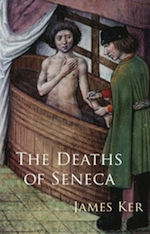It may be true that we only die once, but the death of the famous, especially a classical icon who wrote often and eloquently about death, can be analyzed and interpreted, retold and represented over and over again. In The Deaths of Seneca, classics scholar James Ker presents the first comprehensive cultural history of Seneca's death "from the first century to the present."
Ker is Assistant Professor and Undergraduate Chair of Classical Studies. His research and teaching deal mostly with the Latin literature of imperial Rome, ancient rhetoric and philosophy, and Greco-Roman cultural history. His main focus is on the culture and literature of Rome, especially prose writing from the first century. Ker's book on Seneca received the 2009 American Publishers Award for Professional and Scholarly Excellence in Classics and Ancient History. Currently, he is at work on a book provisionally entitled Beginning the Day in Ancient Rome: Morning Time, City and Self.
A Stoic philosopher, a statesman and a tragedian, Seneca is often characterized as "a man of action and a man of letters," Ker writes. He was a tutor and later an advisor to Nero. Caught up in a plot to murder the emperor, Seneca was sentenced by Nero to kill himself, which among first-century Roman elites was accomplished by cutting one's veins so as to bleed to death. "Many of Nero's enemies died this way," Ker says. "But Seneca made something of a performance of his death: at his suburban villa outside of Rome he opened his veins, took hemlock and died only after a steam bath." The historian Tacitus records that he died slowly but fearlessly in the presence of friends and family, dictating his final thoughts to nearby scribes.
"Seeing death as a part of living rather than as something to be concealed or denied, finds a lot of resonances with ancient approaches to death and dying, or at least to ancient literary idealizations of good deaths such as Socrates' or Seneca's." – James Ker
Seneca wrote extensively about death. In letters and essays he spoke about swiftly-passing time and the shortness of life, urging his readers to ponder their mortality. "No two words better distill Seneca's literary voice than cotidie morimur, 'we die each day,'" Ker writes, "and throughout his writings in prose and poetry Seneca had confronted readers with repeated representations of himself and others facing death."
In The Deaths of Seneca, Ker pulls together accounts by ancient historians of Seneca's self-killing with the writings of Seneca and the 2,000-year tradition of interpretation to explore the meaning and legacy of this classical Roman philosopher. "[T]he conversation about Seneca himself has more often than not become a conversation about his death," Ker writes. His book looks at how Seneca's extensive writings on death have shaped historians' reporting on the drama of his self-inflicted death and how later interpreters have retold that story.
"Looking at the death scene offers a window on the ways in which Seneca has been re-imagined," Ker explains. "In one version he is an Epicurean hedonist enjoying death in the bath; in another he is a Christian baptizing himself in blood and water. The history of this death scene also offers a window on the ways death and suicide have been viewed in the Western tradition, from the 'Roman death' as a liberation to modern movements on assisted suicide."
Tota vita discendum est mori, Seneca wrote—"we must spend our whole lifetime learning how to die." Western societies have moved away from a "denial of death" over the last few decades, Ker notes, and are gradually moving toward a more frank and open stance toward mortality. "The legalization of assisted suicide, the defense of euthanasia, the hospice movement and other culturally specific discourses acknowledging mortality are part of a more general movement to allow each person to take control of his or her death. This approach, seeing death as a part of living rather than as something to be concealed or denied, finds a lot of resonances with ancient approaches to death and dying, or at least to ancient literary idealizations of good deaths such as Socrates' or Seneca's."
The Deaths of Seneca offers "the whole story" of this classical statesman and man of letters—his writings, the ancient accounts of his death and the Senecan tradition in art and literature, and how each played off the others over the centuries. "I'm hoping that readers across various fields in the humanities will find it useful," says Ker of his scholarship, "and that students of ancient Rome will find it instructive to learn how later readers reinvented this part of the classical tradition."



